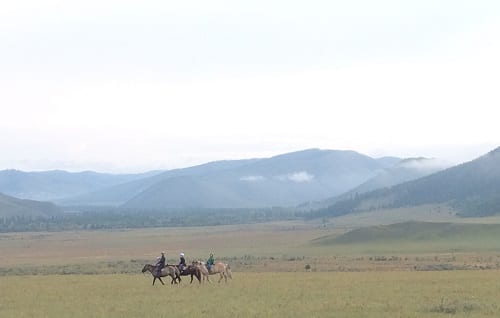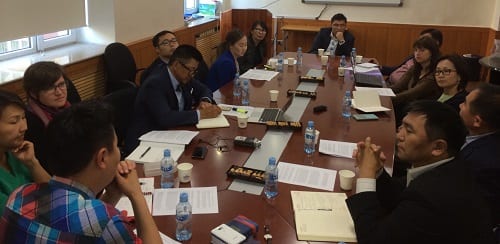Beginning the Fieldwork Phase of our Project
By ucsaar0, on 27 December 2015
This August marked the start of the fieldwork phase of our project. We gathered first in Ulaanbaatar to begin our affiliation at the Department of Anthropology and Archaeology at the National University of Mongolia (NUM), to meet with our paired researchers, and to set up our research visas. The ten researchers on the project – five from UCL and five from NUM – also had a very stimulating meeting with our Advisory Board, and gave a seminar at the Anthropology and Archaeology Department.

Seminar at the Department of Anthropology and Archaeology at the National University of Mongolia, photo by R. Empson.
Many of us brought our children with us, so we were very pleased that Helena Reeve joined us for part of this phase. She held ‘School Club’ with the project’s children every morning. Reading, writing and maths classes were centred around lots of interesting projects, including a study of the Tsam ritual, which resulted in the children making masks and giving their own performance.

Some members of the Emerging Subjects’ ‘School Club’ performing a Tsam Dance with Ms. Reeve, photo by R. Empson.
We are very fortunate to have an active and diverse Advisory Board, ranging from herders to female activists, to independent economists and lawyers – whom we consult on an individual basis. This board was invaluable in advising us at the start of our projects and introducing us to many groups of people and individuals. Having all worked in Mongolia before, the 10 researchers themselves also have different networks that cross over and extend in different directions.
After consulting with different people, we began fieldwork on our topics, in different field sites and among different groups of people. I, for example, have spent this autumn working in pawnshops, and in something called ‘nonbanking financial service centres’ in order to understand how people access cash in Ulaanbaatar and the countryside. Others have been working on construction sites and in ger districts, and others still at Naran Tuul, Ereen and Choibalsan markets. Some have been working on land ownership and mining issues, while others are exploring environmental movements and political protests.
These topics are taking us to different places allowing us to meet a huge range of people while engaging in very diverse activities. One member of our research group, for example, gave a talk at the Government Building on contemporary American knowledge and perceptions of Chinggis Khaan, while another is following the making of a documentary about infrastructure in the ger districts of Ulaanbaatar. Some of us are still on fieldwork while others will be returning again in March.
The project’s title ‘Emerging Subjects’ is focusing our research in two senses. Firstly, we are using this term to explore the broader themes, or subjects, that are emerging in the current economic climate, and their articulation through different kinds of activities. These include forms of political protest, construction and infrastructure projects, and ways of transacting and accessing goods and cash, such as through pawn shops and barter.
Secondly, we are finding that the term ‘Emerging Subjects’ refers to actual people, or to distinct forms of subjectivity that are being articulated as an outcome of particular kinds of economic and political experiences. Here we are looking at gendered forms of political protest, such as hunger strikes and self-immolation, and ways of sustaining life while constantly being in debt. We all share a wider theoretical focus on the way in which particular kinds of economic activity give rise to certain forms of subjectivity and vice versa.
For many of us there is a sense that Mongolia is currently in a gap, between futures that have disappeared from view, and new ones not-yet-realised.[1] The government is focused on the looming election and on how to pay back public loans, some of which are due in 2016. Public discontent is growing, and is increasingly dismissed as ‘populist’ or ‘nationalist’. There is a sense of stalling, of people getting by before things can pick up again or collapse completely.
The situation reminds me of a cartoon featured in the Mongolian media a few years ago. Only now, with increasing public and private debt, and declining commodity prices, the person featured in the cartoon is in the gap rather than standing on its precipice.
In some ways this may not be such a bad place to be – we are finding that there is lots of innovation and creativity in this gap. The substantive adaptation of formal economic models, for example, has lead to lots of exchange along the lines of an ‘economy of favours’, such as barter and informal lending.
The other side of the precipice may not have been reached, but there is the chance to get back up. The minerals (mostly) remain in the ground (albeit with a slow trickle to China) and people’s lives are relatively stable. One issue that we have all found is incredibly prominent in our research areas is debt. In the next few blog posts, we will each report on a particular area of debt that has come to the fore in our research. We hope you will enjoy reading them!
[1] Reference to ‘the gap’ is actually an ethnographically-derived concept that was articulated to me by several people during this period of fieldwork as they described how previous visions of the future have not been met.
 Close
Close









